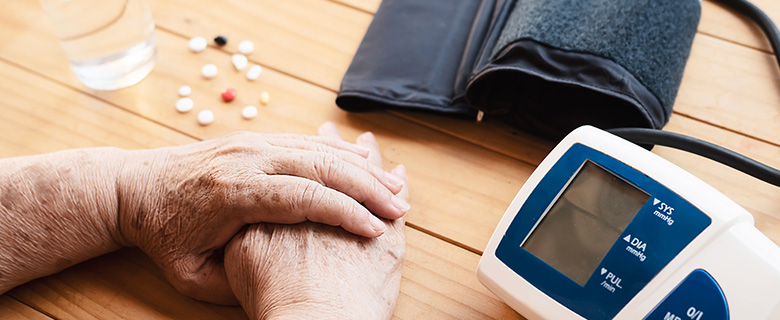
Keeping Systolic Blood Pressure in Check

High blood pressure or hypertension occurs when the heart has to exert excess pressure to pump blood through the body or when the pressure in the arteries is much higher than it should be.
What Is Systolic Blood Pressure?
When the heart pumps blood, it pushes through the arteries to the rest of the body which creates pressure on the blood vessels. This pressure on the artery walls is known as systolic blood pressure.
On the other hand, the diastolic blood pressure indicates how much pressure the blood exerts against the artery walls while the heart rests between beats.
Generally, the normal systolic pressure is below 120 mmHg. If that blood pressure reading is 130 mmHg or more then it indicates high blood pressure or hypertension.
Is Systolic Blood Pressure More Important Than Diastolic Blood pressure?
Actually, normal readings of both the blood pressure numbers are important to maintain normal BP.
An elevated diastolic blood pressure puts the person at a more-than-average risk of developing elevated systolic blood pressure as they age. Also, any increase in the diastolic blood pressure reading, no matter how small, significantly increases the risk of cardiovascular diseases.
But even so, many doctors pay more attention to the systolic blood pressure reading as it is considered a major risk for developing cardiovascular diseases, especially in people over the age of 50. For most people, the systolic blood pressure rises steadily with growing age as there is stiffening of the large arteries, long term plaque buildup as well as more occurrences of cardiac and vascular disease.
But physicians may take either an elevated systolic or an elevated diastolic blood pressure reading to diagnose high blood pressure. According to recent studies, the risk of death from ischemic heart disease and stroke doubles with every 20 mm Hg systolic or 10 mm Hg diastolic increase among people from age 40 to 89.
How To Keep Your Systolic Blood Pressure In Check?
In most cases though, lifestyle changes can have a positive effect in controlling high blood pressure. Read to know some useful tips on how you can keep your systolic blood pressure in check:
- Exercise Regularly –
 Most doctors recommend physical activity of at least 40 minutes in a day. A study showed that sedentary elder adults started aerobics training and lowered their systolic blood pressure by an average of 3.9 % and diastolic blood pressure by a 4.5 %. Aerobic exercise, resistance training, high-intensity interval training, short bouts of exercise throughout the day or walking 10,000 steps a day may all help lower blood pressure. You don’t have to run marathons but simple daily things such as walking short distances instead of taking a vehicle, using stairs to climb up a few floors, cycling, playing a team sport, having a dedicated fitness routine, etc. will definitely help in maintaining normal blood pressure levels.
Most doctors recommend physical activity of at least 40 minutes in a day. A study showed that sedentary elder adults started aerobics training and lowered their systolic blood pressure by an average of 3.9 % and diastolic blood pressure by a 4.5 %. Aerobic exercise, resistance training, high-intensity interval training, short bouts of exercise throughout the day or walking 10,000 steps a day may all help lower blood pressure. You don’t have to run marathons but simple daily things such as walking short distances instead of taking a vehicle, using stairs to climb up a few floors, cycling, playing a team sport, having a dedicated fitness routine, etc. will definitely help in maintaining normal blood pressure levels. - Watch Your Weight –
 Obesity is one of the factors that can increase the risk of you developing high blood pressure. Some studies have reported that weight loss helped reduce systolic blood pressure by an average of 4.5 mm Hg and diastolic blood pressure by a 3.2 mm Hg.
Obesity is one of the factors that can increase the risk of you developing high blood pressure. Some studies have reported that weight loss helped reduce systolic blood pressure by an average of 4.5 mm Hg and diastolic blood pressure by a 3.2 mm Hg. - Control The Sugar And Carbs –
 Limiting your sugar and carbs intake helps lose weight and lower blood pressure. Studies conducted over years show that a low carb diet lowered diastolic blood pressure by 4.5 mm Hg and systolic by 5.9 mm Hg.
Limiting your sugar and carbs intake helps lose weight and lower blood pressure. Studies conducted over years show that a low carb diet lowered diastolic blood pressure by 4.5 mm Hg and systolic by 5.9 mm Hg. - Consume More Potassium, Less Sodium –
 There is a direct relation of high intake of sodium and high blood pressure. But increasing your potassium intake and reducing sodium can help lower blood pressure levels. Potassium is vital as it lessens the effects of salt in the system and also eases tension in the blood vessels. Make sure you include potassium-rich foods such as bananas, avocados, peaches, oranges, tomatoes, leafy green veggies, low-fat dairy milk & yogurt, fish in your regular diet. For reducing sodium intake avoid all types of packaged and processed foods, check the labels of food products that you buy for sodium content (only purchase those that say 5 % or less sodium) and remember no extra salt on your food.
There is a direct relation of high intake of sodium and high blood pressure. But increasing your potassium intake and reducing sodium can help lower blood pressure levels. Potassium is vital as it lessens the effects of salt in the system and also eases tension in the blood vessels. Make sure you include potassium-rich foods such as bananas, avocados, peaches, oranges, tomatoes, leafy green veggies, low-fat dairy milk & yogurt, fish in your regular diet. For reducing sodium intake avoid all types of packaged and processed foods, check the labels of food products that you buy for sodium content (only purchase those that say 5 % or less sodium) and remember no extra salt on your food. - Avoid Smoking & Limit Alcohol Consumption –
 Smoking causes an immediate, but temporary, increase in the blood pressure as well as the heart rate. Tobacco (even passive smoking) is harmful as it can damage blood vessel walls, causing inflammation and narrowing the arteries. Narrowed arteries restrict blood flow and exert more pressure on the heart causing high blood pressure. Similarly, alcohol can raise blood pressure by 1 mm Hg for each 10 grams of alcohol consumed so drinking in moderation is highly recommended.
Smoking causes an immediate, but temporary, increase in the blood pressure as well as the heart rate. Tobacco (even passive smoking) is harmful as it can damage blood vessel walls, causing inflammation and narrowing the arteries. Narrowed arteries restrict blood flow and exert more pressure on the heart causing high blood pressure. Similarly, alcohol can raise blood pressure by 1 mm Hg for each 10 grams of alcohol consumed so drinking in moderation is highly recommended. - Get Ample Sleep –
 The blood pressure levels dip when a person is asleep. Sleep deprivation or fitful sleeping habits can increase the risk of developing high blood pressure (especially middle aged people). A study found that regularly sleeping less than 7 hours a night and more than 9 hours a night was associated with an increased prevalence of hypertension. Regularly sleeping less than 5 hours a night was linked to a significant risk of long term hypertension. If your blood pressure (systolic or diastolic) is still high even after making these lifestyle changes then consult your doctor again for further treatment.
The blood pressure levels dip when a person is asleep. Sleep deprivation or fitful sleeping habits can increase the risk of developing high blood pressure (especially middle aged people). A study found that regularly sleeping less than 7 hours a night and more than 9 hours a night was associated with an increased prevalence of hypertension. Regularly sleeping less than 5 hours a night was linked to a significant risk of long term hypertension. If your blood pressure (systolic or diastolic) is still high even after making these lifestyle changes then consult your doctor again for further treatment.

Note of caution: This article is for information purposes only. Always consult your doctor in case of any blood pressure or other health-related problems.

Comments (4)
Naveen
Good information. This is helpful
Kinjal
Systolic pressure also needs to be controlled, never knew!
Aayushi
I must say it’s a good read.
Suraj
Informative!
Add your comment